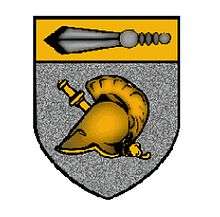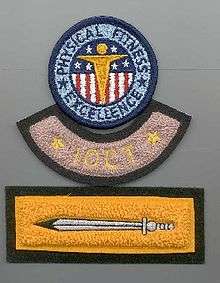Department of Physical Education
 | |
| Type | Physical Education Department |
|---|---|
| Established | 1948 |
| Department Head | COL Nicholas Gist |
Administrative staff | 49 Instructors & Professors |
| Location | West Point, New York |
| Nickname | "The Department with a Heart" |
| Website | www.usma.edu/dpe |
The Department of Physical Education (also known by its initials DPE) is the academic department that oversees the physical development program at the United States Military Academy at West Point, NY. DPE is headquartered in the Arvin Cadet Physical Development Center. DPE has 24 Military faculty and 25 civilian instructors and professors. The head of the department holds the ceremonial title of Master of the Sword, known within the department as the MOS. This title dates back to when the Cadets at West Point were taught swordsmanship as part of their military & physical training. The current Master of the Sword is COL Nicholas Gist, who has held the position since 2015. The department's stated mission is:
| “ | The Department of Physical Education develops warrior leaders of character who are physically and mentally tough by engaging cadets in activities that promote and enhance a healthy lifestyle, physical fitness, movement behavior, and psychomotor performance.[1] | ” |
Duties of instructors
Instructors and professors in DPE have a wide range of duties and responsibilities. In addition to evaluating one of the core physical program courses, instructors teach an elective lifetime sport and/or a cognitive exercise science or applied fitness course. Instructors also serve on additional committees such as the Competitive Sports, Testing, & Assessment committees, or may work with the department's operations & plans, or personnel sections.
Academic courses

DPE is responsible for teaching several core courses. To meet this requirement, the department is organized into four "committees". All 49 instructors are a member of one of the four committees. The current DPE committees are:[3]
| Committee | Course | Class Year |
|---|---|---|
| Military Movement | PE117 – Military Movement | Fourth Class (Plebes) |
| Boxing | PE116 – Boxing | Fourth Class (Plebes) |
| Swimming | PE109, 320-323 – Swimming | Fourth & Third Class (Plebes & Yearlings) |
| Combatives | PE360 – Combat Applications | Second Class (Cows) |

Kinesiology major
In 2006, the USMA Academic Board approved DPE to begin offering an academic major for USMA Cadets. The Kinesiology major is taught by professors from DPE's Human Performance Laboratory in conjunction with the Department of Chemistry and Life Sciences. The first cohort of USMA cadets to declare as Kinesiology majors was the class of 2010. Demand for the major is strong and applicants must pass a screening board to be admitted to the program.
Other activity courses
DPE offers a wide range of elective athletic instructional courses, known to the department as "lifetime physical activities" (LPA), that are taken as electives by the upper class cadets, primarily 3rd (Yearling) and 1st Class (Firstie) Cadets.[4] Because of the strong seasonal changes at West Point, many courses are only offered at certain times of the year. Additionally, team sports that are strongly associated with a certain time of the year (i.e.: Basketball in the winter/spring) are taught at those corresponding times. Current DPE elective courses include: advanced close quarters combat (with striking weapons), advanced grappling (with ground striking), aerobic fitness, basketball, cycling (road & mountain), lifeguard training, golf, ice skating, judo, badminton, racquetball, rock climbing, scuba diving, skiing (x-country & downhill), snowboarding, soccer, strength development, tennis, & volleyball.
Cognitive courses
In lieu of teaching the course formerly called Master Fitness Trainer by the Army, DPE now teaches two separate lifetime fitness courses to Cadets. The Yearlings (Sophomores) receive PE215, The Fundamentals of Physical Fitness. This course is a 19 lesson course in the basics of health and wellness. Cadets learn basic exercise physiology such as the differences in skeletal muscle fiber types, the effects of low and high-intensity training, nutrition, and healthy lifestyle choices. The course is very much geared towards teaching an individual how to achieve personal lifelong fitness. All Firsties (Seniors) take PE450, Army Fitness Development, which is also 19 lessons. This course briefly reviews the physiology principles taught in PE215 and then applies them to training small units such as squads and platoons. The course is more focused on planning and assessing fitness goals at the small unit level.
Testing
DPE is responsible for administering the Indoor Obstacle Course Test (IOCT). This fitness test is mandatory for all Cadets and must be passed in order to graduate from the Academy.
IOCT
The IOCT is a test of all-around functional physical fitness administered by DPE in the historic Hayes Gymnasium.[5] Hayes Gym, built in 1910, is the oldest part of the newly renovated Arvin Cadet Physical Development Center.[6] Many current and past graduates and faculty consider the IOCT to be one of the best evaluations of total body fitness given in the Army.[7] Cadets who earn an A- (2:38 or less for Males and 3:11 or less for Females) are authorized to wear the IOCT Badge on their athletic shorts.[8]

The IOCT is similar to the obstacle course seen on the TV show American Gladiators, with a quarter-mile sprint at the conclusion of the course. The IOCT is administered throughout the academic year based on dates published by DPE. There are primary testing dates in both Fall and Spring semesters; generally, the dates are dependent upon class year and regiment. Cadets take the IOCT at different time throughout the year because of participation in semester abroad, in-season Club or Corps Squad teams, or injury. Large crowds of cadets, tactical officers, and other onlookers gather for the running of the IOCT. The IOCT is often referenced in articles concerning high intensity human performance,[9][10][11] especially involving obstacle courses.[12] This is due to the large amount of available date due to the lengthy history of the course. It has been administered, almost without changes, since 1944.
Test sequence
The Test consists of 11 events performed sequentially: low crawl under barrier, tire footwork, two-handed vault, 8' horizontal shelf, horizontal bar navigation, hanging tire, balance beam, 8' horizontal wall, 20' horizontal ladder, 16' vertical rope, and 350m sprint carrying a 9 lb medicine ball for the first 120m.[13] Because of the unique level of athletic skill needed to pass the test and the tremendous level of effort needed to excel at it, the IOCT holds a special place in the hearts of all West Point Cadets and Graduates. A simple search of YouTube or Google video will return many videos about it, both serious and comical. [14] [15] [16] [17][18] [19] The IOCT is both feared and revered[20] by the Members of the Long Gray Line[21] and is seen as a link between Graduates of long ago and Cadets of today[22] as the test has not changed much since 1948.
Competitive sports
DPE is also responsible for the administration of a robust competitive sports program at the Academy. All Cadets must participate in one of three athletic categories: an NCAA Intercollegiate Sports Team (called "Corps Squad"), an authorized Club Sport Team (called "Club Squad"), or an intramural sport team – known at West Point as "Company Athletics". About 20% of all Cadets are Corps Squad, about 15% are Club Squad, and about 65% are Company Athletes.
DPE's Competitive Sports Committee,[23] headed by Dr. Ralph Pim, has been national recognized as one of the 15 Most Influential Sports Education Teams in the country by the Institute for International Sport.[24] Dr. Pim's Committee oversees the Club and Company Athletic programs, while the Director of Intercollegiate Athletics (DIA) oversees the NCAA sports program.
Club sports
West Point currently fields 24 Club Teams in the following sports: Boxing, Crew, Cycling, Equestrian, Fencing, In-Line Hockey, Judo, Lacrosse (W), Marathon, Martial Arts, Mixed Martial Arts (MMA), Mountaineering, Orienteering, Rifle & Pistol, Rugby (M&W), Sailing, Skiing (Alpine & Nordic), Team Handball (M&W), Triathlon, Volleyball (M), & Waterpolo.[25] Since 2000, Academy Club teams has won 22 national championships, making West Point's club program one of the premier competitive club programs in the nation. In 2008, West Point had four National Championship Teams: Cycling, Orienteering, Men’s Team Handball and Boxing.

A list of recent Club Team National Championships:[26]
- 2011 – Cycling
- 2010 – Triathlon
- 2008 – Orienteering
- 2008 – Women's Pistol
- 2008 – Men's Team Handball
- 2008, 2009 – Boxing
- 2008 – Combat Weapons
- 2007 – Women's Team Handball
- 2007 – Cycling
- 2006 – Pistol
Company athletics
Every cadet who does not compete on a Varsity or Club sport must participate in a Company-level athletic sport. About 65% of all cadets compete in Company Athletics. The Department of Physical Education's (DPE) Competitive Sports Committee, headed by Dr. Ralph Pim, runs the Club and Company Athletics sports program and was named one of the 15 Most Influential Sports Education Teams in America by the Institute for International Sport.[24] Each Company in the Corps of Cadets (total of 32) fields a team in the following sports:[27]
| Fall Season | Spring Season |
|---|---|
| Basketball | Combative Grappling |
| Handball | Floor Hockey |
| Football | Orienteering |
| Soccer | Rugby |
| Ultimate Frisbee | Sandhurst |
| Wrestling | Swimming |
Each company fields a team entry into the annual Sandhurst Competition, a military skills event conducted by the Department of Military Instruction in late Spring each year. Participation in Sandhurst counts as spring Company Athletic credit. Many companies train year-round for this prestigious event. The championship game of CA football and other outdoor events are held each year on Daly Field.[28]
References
- ↑ http://www.usma.edu/dpe/vision.html
- ↑ http://www.usma.edu/dpe/
- ↑ http://www.usma.edu/dpe/courseofferings.htm
- ↑ http://www.usma.edu/dpe/Curriculum/White%20Book/Whitebook_08.pdf
- ↑ West Point:Corps building new facilities to train, teach Army future leaders. US Army Corps of Engineers Update Feb 2003, Vol 27, No. 2
- ↑ Arvin Cadet Physical Development Center grand opening Pointer View 19 August 2005
- ↑ Fit & Active Human Kinetics, LeBoeuf & Butler, 2008
- ↑ Cadet Awards Cadets of West Point
- ↑ Impact of Body Weight on Performance of a Weight-Supported Motor Fitness Test in Men Military Medicine, Volume 173, Number 11, November 2008 , pp. 1108–1114(7)
- ↑ Hysiological determinants of performance on an indoor military obstacle course test Military Medicine, Dec 1999
- ↑ Impact of body size on women's military obstacle course performance. Biomed Sci Instrum. 1997;34:357–62
- ↑ The Obstacle Course: Building Fitness and Skill with Fun he Journal of Physical Education, Recreation & Dance, Vol. 70, 1999
- ↑ INDOOR OBSTACLE COURSE TEST PERFORMANCE STANDARDS Department of Physical Education, USMA
- ↑ An instructor runs the IOCT in 1 min 59 sec YouTube
- ↑ An instructor runs the IOCT YouTube
- ↑ First Person view of the IOCT YouTube
- ↑ Creation of the IOCT YouTube
- ↑ The IOCT YouTube
- ↑ Tim Clarke runs the IOCT YouTube
- ↑ Duty First Ruggero, HarperCollins, 2002
- ↑ Observations at a 25th Reunion West Point Association of Graduates
- ↑ Praetorian Guard: Dec 15 PoorCadet.com
- ↑ http://www.usma.edu/dpe/competitivesports/cshome.htm
- 1 2 http://www.internationalsport.com/top100Press.cfm
- ↑ http://www.usma.edu/dpe/competitivesports/DPE%20CC%20Teams.htm
- ↑ http://www.usma.edu/uscc/dca/index.html
- ↑ http://www.usma.edu/dpe/competitivesports/csintramurals.htm
- ↑ https://www.youtube.com/watch?v=ZkAFDJA5h-o
